One of the strong points that the Apollo proponents push forward is that the Apollo astronauts would have put on the moon retroreflectors which are able to send back a laser beam. They take it as a definitive proof that man has landed on the moon. |
 The Apollo retro-reflectors are constituded with corner prismatic cubes which have the property of sending back a luminous ray exactly in the direction it came from, whatever the angle under which they receive this ray. This property allows them to send back the laser beam in a perfect way. |
People generally think that the laser operators just aim the laser at the retroreflector on the moon, that it arrives exactly on the laser reflector on the moon, as concentrated as the surface of the retroreflector, and that this one sends back the whole laser beam. But it is far from being that simple. |
 If, at a short distance, these retro-reflectors work fine, it is different which a so huge distance as the one which separates the moon from the earth. As the laser specialists admit it, the laser beam is deviated by atmosphere of more than a kilometer... |
 ...and the laser beam consequently has to be swept so it can find a retro-reflector as small as the one which would have been left by the astronauts on the moon (which has a side of less of a half-meter). |
Is the beam was arriving on the moon as concentrated as the reflector's surface, searching the reflector would be a true nightmare and would take an eternity, given the great search surface (in two dimensions!), for the retro-reflector would hardly represent a ten millionth of the search area. And, even if the laser beam was miraculously managing to find it, it would lose it as quickly, for the atmosphere keeps deviating the laser beam; moreover the moon is not static, it moves on its orbit at an average speed of 130 km/h, so it moves of around two kilometers every minute, and we would have to believe that the laser would be able to follow a reflector which has a side of a half meter during several minutes while the moon moves of several kilometers meanwhile? |
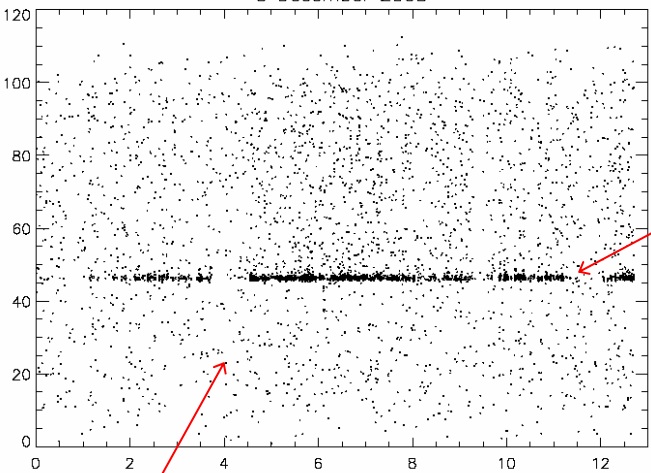 This is the graph of points returned from the moon. The points represent the detection of photons; the vertical coordinate represents the difference of time of reception of the signal, and is graduated in nanoseconds. The horizontal coordinate represents the duration of the measure, and is in minutes. In a nanosecond , the lights travels 30 centimeters (the light speed is 300,000,000 m/s), but, as the laser must make a double travel to go to the moon and back, this distance must be divided by two; so a nanosecond corresponds to a variation of distance of 15 centimeters. We can see that there is a horizontal bar of photons which is more dense for a given value of the vertical coordinate than for the other values of this coordinate, and that this bar is in a "width" of around three nanoseconds; it means that the best reflection is in a range of less than 45 centimeters; that doubtlessly means that the laser beam has met a reflective surface which sends back the beam fairly well. Because the detection is concentrated in a range of around 45 centimeters, and that the size of the reflector is compatible with this range, the Apollo believers think that it proves that the laser beam has bounced on the retro-reflector, but it is completely wrong: This range represents a variation of distance, and not the width of the surface which is struck by the laser beam and sends it back! It is impossible to determine the size of the surface which sends the laser beam back from the received echo, ONLY ITS DISTANCE! The progress which has been made on the laser only allows to measure with more precision the distance that the laser travels, but not the localization and the size of the target which is struck by the laser beam. We can see that there is a cloud of points on a difference of distance which spans on 120 nanoseconds, which represents 18 meters. Given the size of the retroreflector, most of these points can only come from the lunar surface, which proves it is able to send back the laser beam. |
 In reality, the laser beam arrives very diffracted on the moon and strikes it on an area of more than a square kilometer; if a reflector exists in this area, it will represent an extremely small portion of it, and so it will contribute very little to the reflected signal, even if it reflects it very well. |
In an article, "The Laser's Bright Magic", published in the National Geographic magazine by Thomas Mellow, the author relates an experiment which proves that a laser beam can bounce on the moon and successfully return to the earth: "Four years ago, a ruby laser considerably smaller than those now available shot a series of pulses at the moon, 240,000 miles away. The beams illuminated a spot less than two miles in diameter and were reflected back to earth with enough strength to be measured by ultrasensitive electronic equipment". So, as soon as 1962, it was already possible to bounce a laser beam on the moon, much before the moon missions, without a retreflector being necessary for that purpose.  Besides, the moon is so reflective that its reflectivity is used by radiotelescopes to obtain the lunar relief. The principle is that the radiotelescope sends ultra-short waves to the moon, and measures the time that these waves take to come back from the moon; it then sweeps the moon with its signal to obtain the return differences of the signal, and so the relief of the studied area.  For instance, a radiotelescope sweeping the moon allowed to obtain the relief of a pole of the moon, as shown on this figure. The radiotelescope measures the relief, but does not allow to obtain the shadows, which have been artificially added to make the photo more realistic. And, in order to obtain this result, it has not been necessary to put a retro-reflector everywhere; if the lunar ground was not reflective, it would not work. |
 However, the Apollo proponents try to save the situation by saying: Ok the points outside the concentrated bar of returned photons effectively come from the lunar surface, but the concentrated bar on the mddle of the graph comes from the retroreflector, for it reflects better the laser beam than the lunar surface itself. |
 The retroreflector may well reflect the laser signal, but, as it receives only a very small fraction of the laser signal, it can only retransmit a very small fraction too. And it is not true that two different spots separated by some distance cannot return photons which are seen at a close distance. |
 This demonstration will clear the misconception that two reflective spots which are separated by some distance laterally are also seen at very different distances by the laser. Suppose two retroreflectors on a plane which is perpendicular to the laser beam, and which is set at a distance of 1000 meters from the laser gun. Suppose that one is exactly on the trajectory of the laser beam, and the other one is placed at 100 meters from the first one. People would tend to think that they are seen at quite different distances by the laser gun, but far from it. The simple application of the theorem of Pythagoras shows that the second one would be seen by the laser gun at a distance of 105 meters, so with a difference of 5 meters only relatively to the first retroreflector. And, if the laser gun is at a distance of 10 kilometers, this difference of distance becomes 50 centimeters only. If the laser gun is placed at a distance of 100 kilometers, this difference of distance becomes 5 millimeters, and it becomes less than a millimeter if the laser gun is placed at a distance of 1000 kilometers to the two retroreflectors. And the moon is at 380000 kilometers away from the earth! This means that, if the two retroreflectors were on a plane which is exactly perpendicular to the laser beam, and separated laterally by a distance of 100 meters, the laser gun would see tham exactly at the same distance (the difference of distance would be so small that the laser could not detect it). What does that mean? It means that, for a large area of the moon to send back photons which are within a short range of distance, all what is needed is that this area is averagely well oriented toward the earth, i.e. in a plane which is perpendicular to the laser beam. |
Of course, such favorable areas cannot be found everywhere on the moon; most times the area struck by the laser will be in a plane which is different from the plane which is perpendicular to the laser beam. But, if the laser beam is (patiently and systematically) swept over the lunar surface, it is possible to incidentally find such favorable areas. I am convinced that, before the moon missions, NASA systematically swept the laser beam over the lunar surface to try to find the best reflective areas of the moon, i.e. areas of which the average plane was perpendicular to the laser beam. After it had found some, all it needed to do was to associate these places with the future landing sites. |
 Now, could the concentrated bar of photons representing up to three nanoseconds, which corresponds to a difference of distance of 45 centimeters, come from the retroreflector because this difference of distance does not exceed the size of the retroreflector? |
 If the array of corner cubes is perfectly perpendicular to the laser beam, and the laser gun is placed at 1000 meters from it, knowing that the width of the retroreflector was 45 centimeters, the theorem of Pythagoras tells us thet the difference of distance of two extreme corner cubes would only be a tenth of millimeter. At a distance of 100 km, this difference of distance would become a micron only. And, from the moon, this difference of distance is so small that it can be considered inexistent. |
 Of course, the array of corner cubes is not perfectly perpendicular to the laser beam, but the difference of distance of two corner cubes seen by the laser gun is consistently smaller than the distance which seperates them on the array. If we call D the distance which separates them on the array, H the difference of distance as seen by the laser gun, and a the angle that the array of corner cubes makes with the plane which is perpendicular to the laser beam, we have the relationship: H = D x sinus(a). If the retroreflector has been correctly oriented toward the earth by the astronauts, the angle a is relatively small, which means that the difference of distance seen by the laser gun should not exceed a couple of centimeters. |
 But, on the graph of returned photons, the concentrated bar, which is is supposed to come back from the retroreflector, extends on a width which represents 45 centimeters! And a difference of 45 centimeters corresponds to an angle of around 45° that the array of corner cubes would make with the plane perpendicular to the laser beam (the length in diagonal of the retroreflector is 63cm). This means that the astronauts would have made an extremely bad adjustment of the retroreflector relatively to the direction of the earth. But how were the astronauts making this adjustment? |
 The retroreflector which had been provided to the astronauts was preadjusted so that the array of corner cubes was making with the base of the retroreflector an angle which was equal to the angle that the direction of the earth was making with the local vertical on the landing site. |
 So, all the astronauts were needing to do was to put the retroreflector on a horizontal surface, and turn it in direction of the earth. But, how could they make sure that the base of the retroreflector was horizontal without being sure that the ground on which they were putting it was effectively horizontal? |
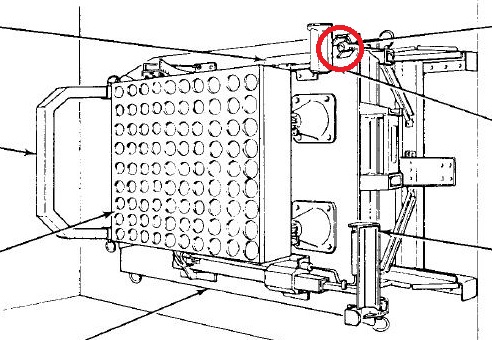 In fact, it was very unlikely that the ground on which they put the retroreflector would be perfectly horizontal, but the retroreflector was equipped with adjustment handles with were allowing to change the orientation of the base relatively to the ground, and to control the horizontality of the base; the retroreflector had a level bubble, I have circled, that the astronauts had to center by manipulating the adjustment handles; when the bubble was correctly centered, the horizontality of the retroreflector's base was achieved. |
 If the astronauts had correctly made the adjustment, there could be a little angular error, but is is difficult to believe that this error could be as much as 45°, resulting in a difference of distance which could attain 45 centimeters! But may be the astronauts, who had been informed of the properties of the corner cubes allowing to send back the laser beam in exactly the same direction it was coming from, whatever their orientation relatively to the beam, told themselves: Why bother to orient this thing since it can correctly send back the laser beam whatever its orientation? |
But at least we should see something quite regular, and, instead of that, we can see something extremely irregular. Sometimes the concentrated bar of photons even completely disappears! It rather looks like it would come from the fact that the laser beam is deviated by the atmosphere, and thus does not always strike the favorable reflective area of the moon at the same place, thus changing the repartition of the returned photons.  Now, if the laser is swept over the lunar surface, the quality of the returned signal will not be constant, and will vary in an important way. It is easy to understand why. If the laser strikes an area of the moon which is inclined relatively to the laser beam, the photons will travel different distances, and will not come back in the same time; the result is that they will appear as a cloud of dots on the graph of the returned photons; there will be no clear position of the returned signal.  On the other hand, if the laser strikes an area of the moon which is averagely perpendicular to the laser beam, or wich includes an sufficiently large area which is such, many photons will travel the same distance, and thus will come back in the same time, and will form a concentrated bar indicating a clear position... So the broadth of the concentrated bar of returned photons entirely depends on the inclination of the average lunar surface relatively to the laser beam. The Apollo landing sites have not been randomly chosen (at least the ones on which a retro-reflector has been put), they have been chosen after a laser ranging test has shown which were the best locations of the moon which were allowing the obtain the most concentrated bars of returned photons.  ...And the graph of the returned photos will appear that way, with a concentrated bar of photons which have come back simultaneously, because they have traveled the same distance; this concentrated bar then indicates a clear position which can be used to evaluate the distance of the moon, and follow the evolution of this distance along time. |
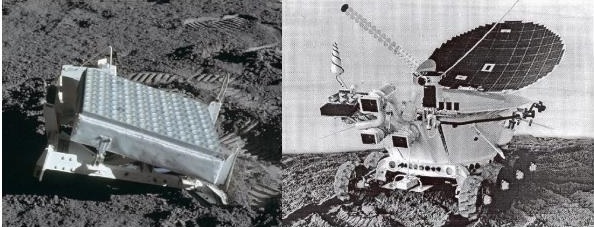 The americans were not the only ones to have retroreflectors on the moon. The russians also had their own retroreflectors which were on their lunokhod rovers which would have supposedly landed on the moon. Normally, the russian retroreflectors should work as well as the american ones, for they also have prismatic reflectors which are able to send back the laser beam in exactly the same direction it comes from. Yet, they don't work as well. This is the official explanation for the fact that they were not working as well as the american reflectors: "The Lunokhod reflectors were aligned to Earth by maneuvering the Soviet-built rovers, thus, yielding alignment less precise compared to that of the Apollo arrays. Since the Lunokhod reflectors are not expected to be as well aligned to Earth (the Lunokhod 2 reflector is likely misaligned by 5° with respect to the mean Earth direction), there may be times when the deviation from normal incidence is higher compared to better aligned Apollo arrays (which likely are within 1° with respect to the mean Earth direction)".  This explanation is completely ridiculous, for both reflectors were equipped with corner cubes which are able to reflect the laser beam in exactly the same direction it comes from. This means that the retroreflectors work the same whatever their orientation relatively to the earth's direction.  And, if the Apollo astronauts had really adjusted the retroreflectors so precisely that there was only 1° difference between the perpendicular to the plane of the cells and the direction of the earth, then the difference of distance of the cells should not exceed one centimeter (corresponding to less than a tenth of nanosecond for the laser).  This means that we should not see a concentrated bar which extends up to three nanoseconds on the graph, but a line which is less than a nanosecond.  This is a graph showing the measures of the laser for two different stations. They are strange these differences and variations while the prisms of the retro-reflector are supposed to send back the laser beam exactly in the direction it came from, and with an extreme precision. Notice that, even if averagely this graph shows that the moon tends to slowly move away, sometimes the moon comes nearer again (and not necessarily for the same station, it may come nearer to a station while it moves away from the other, and vice versa), while it is obvious that the moon is continuously moving away, it is not playing yoyo.  Now I am going to show that the retro-reflectors of Apollo are far from having been adjusted with this precision. The site of Apollo 11 has been circled in red on this map of the Apollo landing sites. Its coordinates were Latitude 0.6875° North, and Longitude 23.4333° East. That means that it had to be oriented toward West, so in the direction of shadows (the sun was coming from East)  If we look on the photo showing the retro-reflector of Apollo 11 (AS11-40-5952), we can effectively see that the retro-reflector was oriented toward the direction of shadows, so its azimuth seems correct. But is its elevation also correct?  Given the coordinates of Apollo 11, the retro-reflector of Apollo 11 had to make with the horizontal an angle of 23.44°.  On the photo showing the retro-reflector, we have a quite good horizon line, which wan be used as reference for the horizontal. And, if we measure the angle between this horizontal line and the orientation of the retro-reflector, we find an angle of 37° instead. That makes a difference of around 14° with the correct angle for the retro-reflector to be directed toward the earth. That's not what I would call a precise adjustment!  And there's still a hint that the retro-reflector of Apollo 11 is a joke. At page 11-22 of the mission report of Apollo 11, the engineers have written something hilarious, which obviously is a joke: "The bubble was not precisely in the center of the leveling device but was between the center and the innermost division in the southwest direction, indicating an off-level condition of less than 30 minutes of arc" The bubble allows to adjust the elevation angle, and they talk about "southwest direction" which concerns the adjustment of azimuth. It is contradictory! Furthermore, if the bubble had been between the center and the innermost division, the error in elevation would not have been of 30 minutes of arc (a half degree), but of several degrees. The explanation for the russian retro-reflectors to work less well than the american ones is in fact much simpler. If the russians retroreflectors were not as well working as the american ones, it is simply because the americans had kept the best reflective places they had found for their own landing sites, and had given less good ones (i.e. with a plane less averagely perpendicular to the direction of the earth) to the russians to support their own hoax! |
 Now, to prove you that these reflectors are a joke, I am going to show you surprising things on the retroreflectors we see in the photos of the missions. On the photo AS11-40-5952, we can see the famous retro-reflector which is supposed to send back a laser beam to the earth. What's strange is that the array of prismatic cells appears entirely black.  Yet this array is quite luminous as we can see on this stereoscopic view. So, would this array be entirely in the shadow?  If this array was entirely shadowed, then, given the direction of the shadows, the part I have outlined in red would be shadowed and would also appear black. And the bar I have circled in orange would also be shadowed and appear black.  So there is no reason that we should not see the array of cells of the retroreflector! |
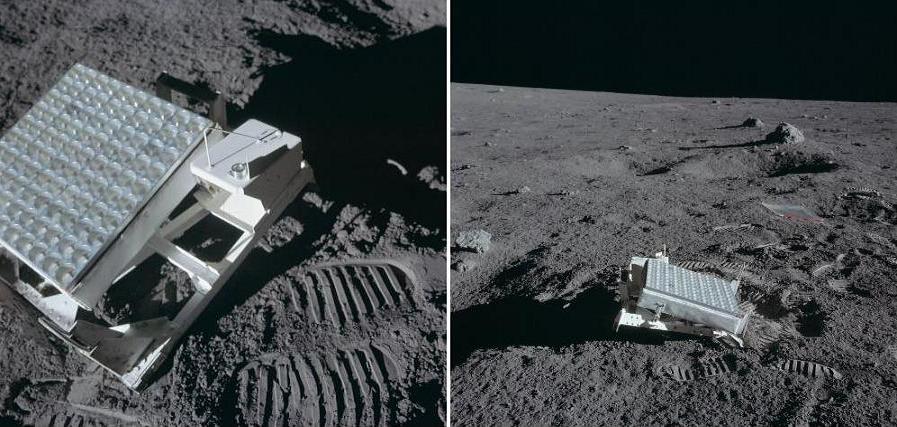 I am also going to show you surprising things on the retro-reflector of Apollo 14. |
 Each of the cells of the retro-reflector consists in a cylinder, and a prism inside this cylinder. The cell that I am showing here looks normal.  But if we look at another cell of the reflector, that I show on the photo of the right, the prism appears to be incorrectly positioned in the cylinder. |
 What we also see is that there are two cells which are duller than the other ones; yet the cells are supposed to be all the same.  And if you think that it's just because they might be shadowed on the first view, I show you another view on which the two same cells are still duller than the other ones. |
 The part I have circled in red on one view is absent on the other view. |
 We are going to examine details on the part I have circled in red on each of the views.  On the first view, we can see a metallic cylinder I have circled in red. But, on the second view, this cylinder is no more metallic, but plastic instead, and besides it is not even more cylindrical, but appears triangular instead.  The shadow of the metallic bar I have circled is well visible on the first view; but, on the second view, it is not visible, or hardly.  If we draw a line along this shadow (on the second view, although most of this shadow is hardly visible, the end of it is very visible), we can see that this line does not make the same angle with the edge. |
 We are also going to examine the part I have circled on each of the views.  The articulation I have circled appears different on the two views. |
 The landing site of Apollo 15 was located on latitude north and almost a null longitude. Therefore, in order to point at the earth, the retroreflector had to be oriented toward the South. At the time of the landing of Apollo 15, the sun was on the East of the landing site, and thence the shadows were oriented toward the West. 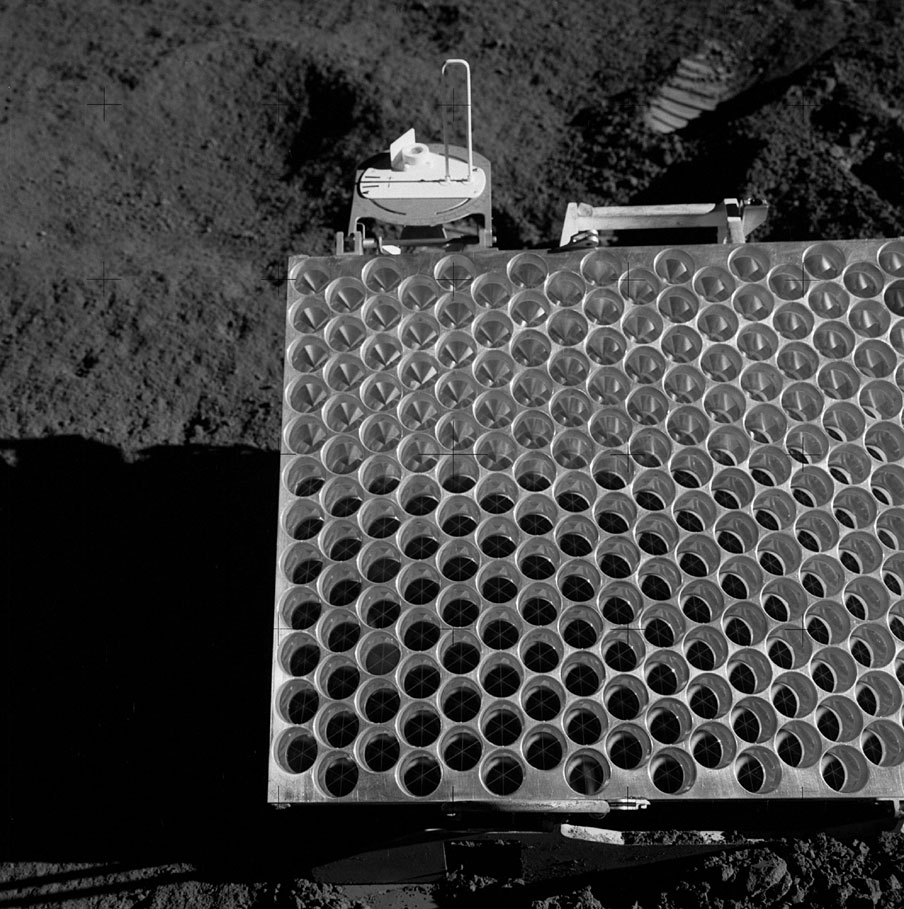 On the retroreflector of Apollo 15, we can see a shadow which comes over it; this shadow is the one of an astronaut which stands on the left of the photo.  I have previously explained that, when the retroreflector of Apollo 15 is correctly oriented to point toward the earth, the shadows should be oriented along the arrow I have drawn in black (because the retro-reflector has to be oriented toward south).  But, on the photo of the retroreflector of Apollo 15 I have shown, the astronaut's shadow which covers it is oriented in direction of the arrow I have drawn in black on this schema, which means that the retro-reflector, instead of being directed toward the south, it would be oriented instead toward the north.  Yet, on the next photo, the retro-reflector's shadow seems to be correctly oriented.  Yet, when we look closer, the solar compass appears to be incorrectly adjusted.  And, on this photo, Irwin's shadow is oriented from the solar adjustment toward the handle. So, either the direction of shadows has brutally changed between the two photos, or the retro-reflector is completely misoriented on this photo.  Moreover I have noticed that there is one of the black cells which appears grey in fact instead of black, whereas all those which are around are black.  There still is another hint that the retro-reflector of Apollo 15 is a joke. In the mission report of Apollo 15, we find these statements (at page 26): "The Mc Donald observatory team initially acquired a return signal from the Apollo 15 instrument August 3, 1971, when atmospheric conditions first permitted ranging." and "No degradation of the retro-reflector appears to have resulted from lunar module ascent engine firing." So what's the problem with these two statements? The problem is that the astronauts left the moon on August 2nd, so before the first ranging test was performed on Apollo 15. In this circumstance, how can they assert that there was no degradation of the retro-reflector between the lift-off of the ascent engine and after, since they have nothing to compare the test made after the lift-off with? |
 In fact these gadgets are just here for the show, they are not serious. The laser beam certainly doesn't bounce on one of these "toys", but either on a natural lunar plate of silica, or eventually on a more serious bigger and adjustable reflector that the Americans might have put on the moon with an unmanned mission. If the Apollo fans want to convince themselves that man has landed on the moon, they have better look for a more serious proof, for this one really looks ridiculous. |